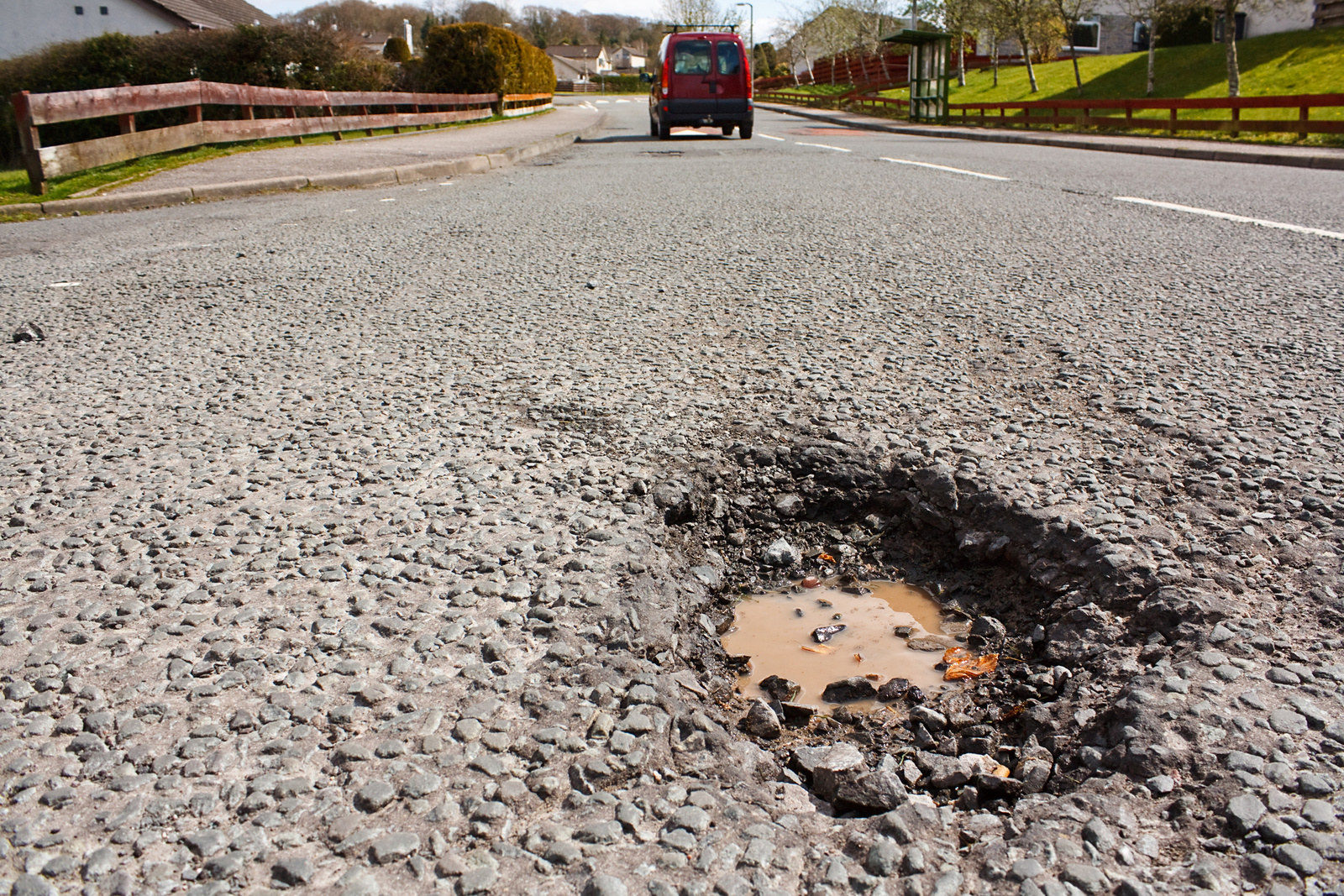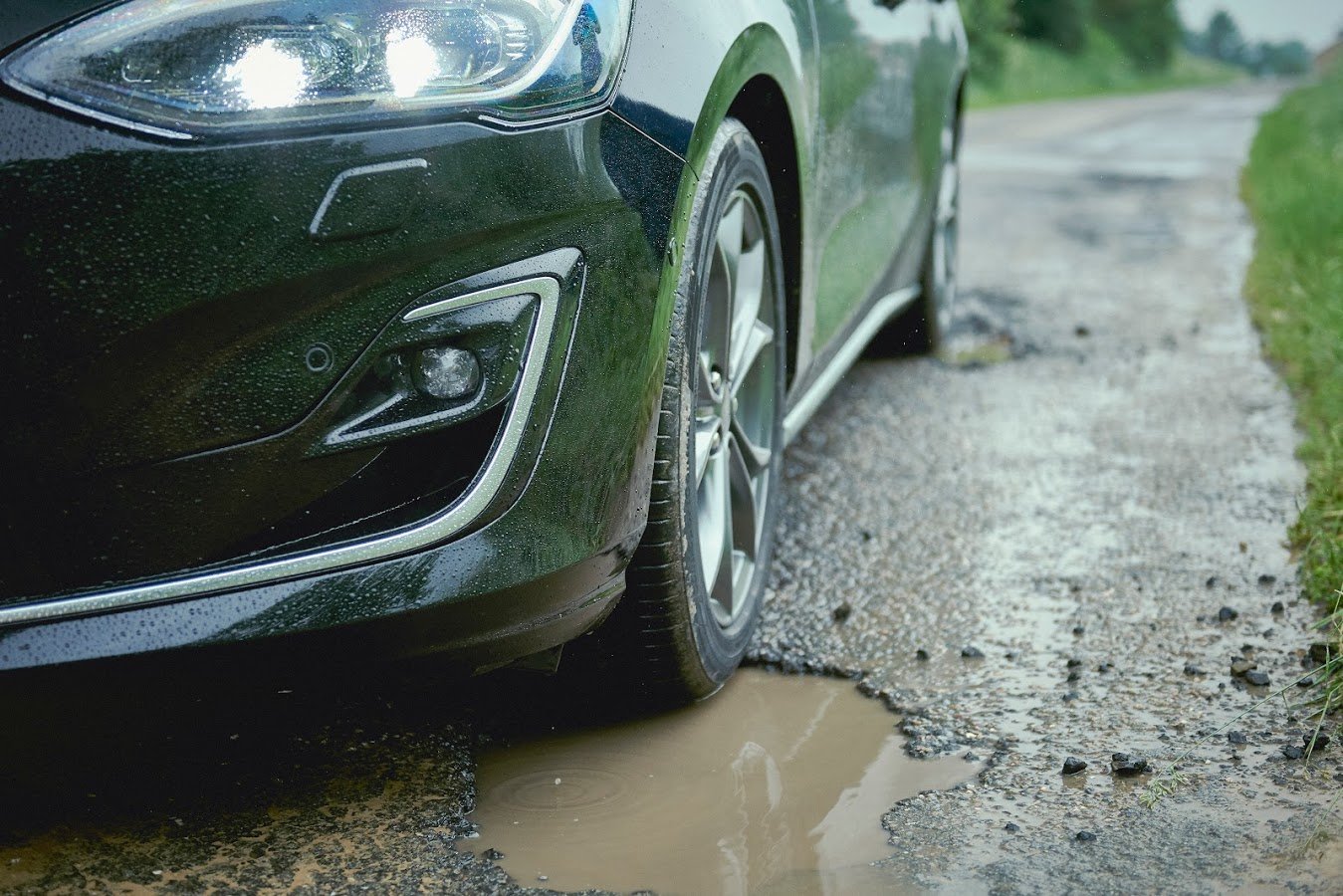At best, the number of potholes on the UK road network has resulted in people completing their journeys in a much bumpier fashion. At worst, potholes represent a danger to road users (including cyclists) and can cause serious damage to your vehicle.
To give you some idea of the scope of the pothole problem, the AA recently reported that it attended 52,000 pothole-related breakdowns in April 2023 alone, a 29% increase on April 2022. The motoring group also stated that, on average, 1735 drivers had suffered damage to their car due to the imperfections on the nation’s roads.
If you happen to be one of those unlucky people, you might be able to recoup the cost of any repairs from the authority in charge of maintaining the road. This guide explains how to claim for pothole damage.
How to Claim for Pothole Damage to Your Vehicle
- What Causes Potholes?
- What to Do If You Hit a Pothole
- How to Tell if a Pothole Damaged My Car
- Gathering Evidence
- How to Claim for Pothole Damage
- My Claim Is Successful
- My Claim Was Rejected
- Making a Second Claim
- Claiming on Your Insurance
- FAQs

What Causes Potholes?
Potholes form for several reasons, including simple wear and tear from vehicles travelling over the same spot time and again. However, they tend to be at their most prolific in the winter months, when water seeps into the ground from puddles and then expands and contracts and it freezes and thaws. Over time, this effectively breaks the road from the inside out, with the surface eventually giving way to form a pothole in the road surface.
What to Do If You Hit a Pothole
Hitting a deep pothole can damage a car’s tyre, wheel rims, steering and suspension. Damage to any of these components could result in your car failing its next MOT. If you hit a bad pothole, it’s a good idea to pull over somewhere safe and write down the details of the incident there and then. Regardless of whether you want to submit a claim for the damage to your car, you should also report the pothole to the authority responsible for maintaining the road so that it can take the necessary steps to repair it. It’s very important to report potholes because not only could it save other motorists or road users from a similar fate, but also because if the authority does nothing about the pothole, it could also help other road users with a compensation claim in the future. More on this later.
How to Tell if a Pothole Damaged My Car
Once you pull over after hitting the pothole, inspect you car an try to spot any obvious damage. In the case of some parts, this is pretty easy. Check that your tyres are still inflated and check both the treads and the sidewalls to make sure that no chunks have been taken out by the impact. At the same time, check your wheels for scuffs, scrapes and cracks, and also check your exhaust system and the lower parts of the body work to see whether anything has been either scraped or dislodged.
Unfortunately, it is much trickier to detect damage to suspension and steering systems, especially to an untrained eye. Obviously, if your car behaves differently on the road after a pothole strike, or it makes noises it didn’t make before, then that can be indicative of a problem. However, just because you don’t detect any differences, it doesn’t guarantee that that something hasn’t been damaged, causing your car problems. After any bad pothole strike, we’d recommend getting your car looked over by a professional mechanic to make sure that your steering and suspension are working as they should.

Gathering Evidence
If you do want to make a damage claim, you’ll need plenty of evidence. If it is safe to take photographs of the pothole, you should do so, preferably with an item such as a drinks can or folded newspaper in the picture for scale. If you can safely measure the pothole, then do that, too. Also sketch its location in relation to surrounding objects (road markings, for example), and write down the road name, the direction in which you were travelling, and—if relevant—the postcode, village, town, or city in which the pothole is located. You want to record anything, basically, that will help the relevant authority locate it.
When making a claim, you’ll need to state why you think the damage to your car is the fault of whoever maintains the road (for example, the local council) and not you as the driver. Factors such as the pothole being around a blind corner can be evidence in your favour, as can any witnesses to the impact, so take their details if they are happy to provide them.
At this stage, it’s a good idea to get quotes from a couple of garages to gauge how much repairing the damage will cost. At the same time, to give you the best chance of making a successful claim, you should ask them to write a short note confirming that the type of damage, and the repairs required, are consistent with pothole damage.
In most cases, it’s best to get the repair done and paid for and then try to reclaim your money from the authority in charge of the road. However, if the damage is purely cosmetic, such as a scuffed wheel, it might pay to wait until you know if your claim has been successful before commencing repairs.
How to Claim for Pothole Damage
In order to make a claim, you first need to know which authority is responsible for the stretch of road in question. If it’s a motorway or national A-road, this will most likely be Highways England, Transport Scotland, Trunk Road Agents in Wales, or TransportNI in Northern Ireland.
If it’s a local road, you'll need to locate the local authority, which is the borough, city, or county council for the area. Many organisations and authorities will have their own form to complete for pothole claims. If not, phone them and ask what the best procedure is.
In either case, you should send the following as supporting evidence for any claim:
- Details of when and where the damage occurred (include a basic sketched map)
- The extent of the damage to your car
- The total cost of repairs
- A statement from the repairer confirming the damage was caused by a pothole
- Photos of the pothole
- Measurements of the pothole
- Any supporting witness statements
It’s important to be polite at all times, whether by phone, letter, or email, because any communications might be used as evidence if the case ends up in court.
My Claim Is Successful
In some circumstances your initial claim will be accepted and you will receive a payout for the full amount for any repairs carried out to your car. Alternatively, an authority might try to settle part of the cost. In this instance, you need to weigh up whether to accept the settlement or to pursue the full amount. If it’s the latter, or your claim was rejected, read on.

My Claim Was Rejected
In many cases authorities reject claims for damage caused by potholes, often citing Section 58 of the Highways Act. This basically states that the authority took all reasonable steps to ensure the road was correctly maintained.
This doesn’t mean game over, but if you do want to continue to pursue the claim, you will need to prove the authority has in fact not complied with its guidelines on road maintenance—for example, if a pothole had been reported by another road user and not repaired within a reasonable timeframe.
In order to build evidence, you will need to submit a Freedom of Information (FOI) request to the relevant authority. This is much simpler than it sounds (it can be a straightforward letter addressed to its FOI department) and means the authority is legally obliged to reply. Specifically, you are requesting a copy of the authority’s road-maintenance guidelines, as well as its maintenance log for that particular road for the two months leading up to your claim.
When the information arrives, you’ll need to spend time going through it in detail and looking for any discrepancies between the guidelines and the maintenance log that prove the pothole should have been repaired. If you are making a claim against a local authority, it is also worth comparing its own code and the national Well-Maintained Highways Code of Practice to ensure it meets those standards. If not, and you can demonstrate as much, then it’s another point in your favour.
Making a Second Claim
With evidence gathered, it’s time to submit another claim outlining any shortcomings in the authority’s maintenance and pothole repair actions compared with its own code and also any shortcomings in its code versus national standards. When you make this claim, it’s important to include copies of any documentation from the first time around, such as the extent of the damage to your car, the repair costs, and any supporting witness statements.
It is at this stage an authority is most likely to settle the claim in full or in part. If it’s the latter, you’re unlikely to receive more money without taking the case to court, so it might be more cost-effective to accept and move on.
If you are still unsuccessful, the next stage is legal action, in which case it is important to first seek professional legal advice. The same applies if you have suffered a personal injury as a result of pothole damage and want to claim compensation, whether you were travelling by car, motorcycle, or bicycle.

Claiming on Your Insurance
At any stage in this process you might be able to claim for repairs on your car insurance rather than seeking compensation, provided your policy is fully comprehensive. However, you need to weigh up if it’s worth putting any no-claims bonus with your insurance company at risk, as well as face price increases to any insurance policies in years to come as a result of having made a claim, because most providers will increase premiums as a result.
It’s also worth remembering that, while claiming for pothole damage can be a convoluted and time-consuming process, many people have been successful. If you’ve got a genuine case for pothole compensation, it stands to reason that you could be successful, too.
FAQs
How do I file a claim for pothole damage?
First figure out which authority is responsible for the road in question (a highway agency or local council, depending on the type of road). Each will likely have their own form to complete, so get in touch with them and ask them for a copy, or if they don’t have a form, ask them the best way to proceed with a claim.
What parts of the car are most susceptible to pothole damage?
Wheels and tyres are most at risk of damage from potholes, and damage is quite easy to spot in these cases. However, suspension and steering components can also be damaged, and issues with these components is much trickier to spot, so it’s worth enlisting the help of a professional mechanic. If a potholes is particularly deep, it’s also possible that your exhaust and the lower parts of the bodywork could be affected.
Is pothole damage covered by insurance?
If you have a fully comprehensive insurance policy, then you can claim on your insurance in most cases. However, do be aware that you could lose your no-claims bonus, and even if you have a protected no-claims bonus, your annual premiums will likely go up if you make a claim.

